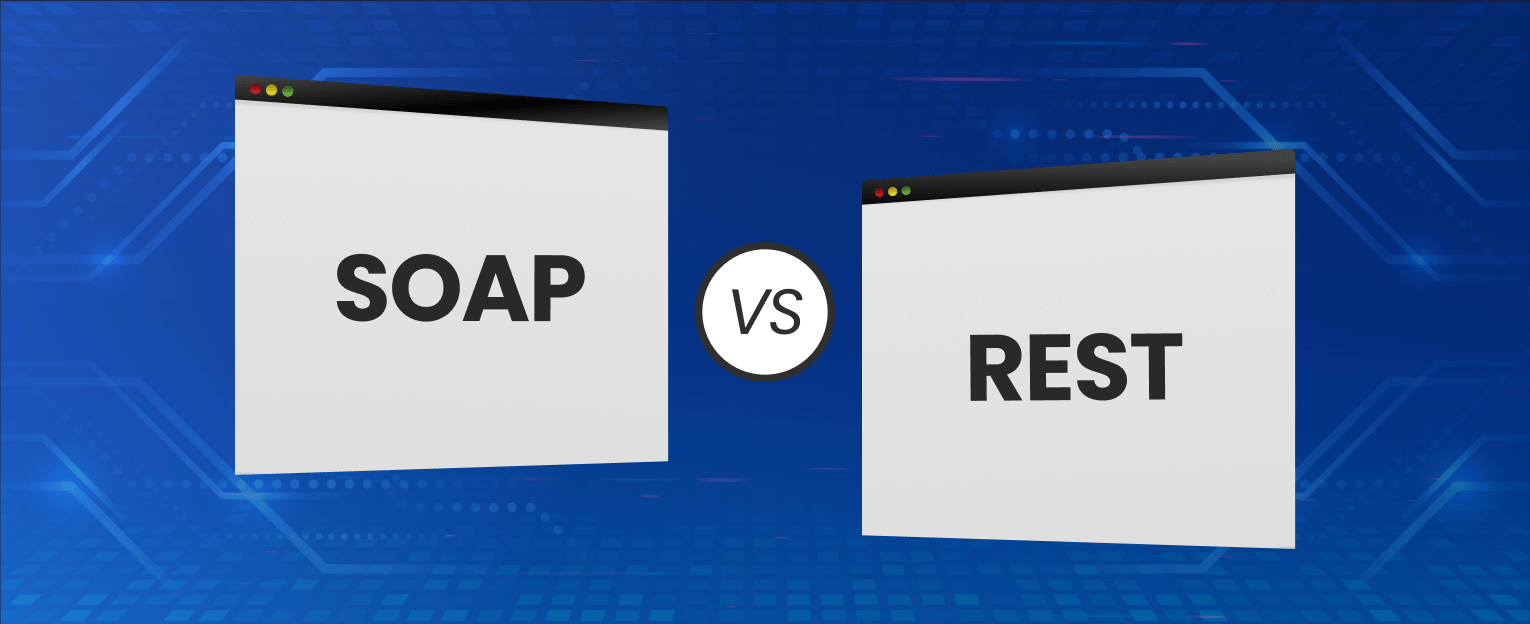You might have heard about SOAP and REST web services in the context of application integration and data exchange. Today, we’ll explore web services and compare SOAP vs. REST.
They enable software applications to interact over the internet and exchange information. These systems use standardized rules and protocols for data and functionality exchange.
This makes it possible for them to work together without getting affected by the underlying structure of those applications. Imagine you have two applications.
One manages your calendar, and another provides weather information. Now, let’s say you want your calendar app to display the weather for each day. This is where web service protocols come in.
Instead of the calendar app trying to understand the weather data itself, it can make a request to a web service that specializes in providing weather information.
Here’s a simple process of how the two applications will communicate, using web service protocols, in this scenario to make the data available for the end-user:
- Request: The calendar app sends a request to the weather web service, asking for the weather information for a specific date.
- Processing: The weather web service processes the request and gathers the relevant weather data.
- Response: The weather web service returns the weather information to the calendar app.
- Integration: The calendar app is now capable of integrating this weather information into its display. This is what shows you the weather alongside your scheduled events.
In this case, the web service plays the role of a go-between. It enables diverse applications to exchange and employ data. This is possible without comprehending the complexities of the other app’s internal functions.
This standardized way of communication makes it easier for developers to create integrated, efficient, and modern software systems.
While discussing web services and web service protocols, you will also come across the term APIs. Often, APIs and web services are used interchangeably.
However, an API is a set of rules that describes how different software components should interact. Plus, it authorizes multiple software applications to communicate with each other.
Web services can use different protocols, with two common ones being REST (Representational State Transfer) and SOAP (Simple Object Access Protocol). SOAP employs the XML data format and follows a highly structured methodology.
On the contrary, REST is characterized by greater flexibility, enabling applications to interchange data in various formats.
This article revolves around comparing SOAP and REST web services. Along with identifying which API format, SOAP API vs REST, or web service protocol is best suited for your business needs.
Learn more about cloud computing vs. traditional computing and which approach is best for your business requirements.
Understanding REST (Representational State Transfer) APIs:
REST APIs, short for Representational State Transfer Application Programming Interfaces, are more than just a set of rules. They embody principles for designing web services.
These services enhance communication among various software applications. REST, as an architectural style, employs standard HTTP methods.
These include GET, POST, PUT, and DELETE. These methods are used to perform operations on resources.
Resources can be any entity or object, such as data or services. To decide about SOAP and REST web services, give these features an attentive read.
Key Characteristics of REST APIs
- Statelessness: Each request from a client to a server holds all the necessary data for comprehending and executing the request. The server doesn’t retain any client state information between requests.
- Resource-Based: REST is centered around resources, each identified by a unique URI (Uniform Resource Identifier). Resources can represent data, services, or other entities.
- HTTP Methods: RESTful APIs utilize standard HTTP methods for various operations on resources. For instance, GET is used for retrieving data, POST is used for creating new resources, PUT is used for updating existing resources, and DELETE is used for removing resources.
- Representation: Resources are represented in different formats, commonly JSON (JavaScript Object Notation) or XML. Clients interact with these representations rather than directly with the resources.
- Stateless Communication: RESTful communication is stateless, meaning each request from a client to a server is independent, and the server does not store any information about the client’s state between requests.
REST APIs are widely adopted in modern web development due to some factors like simplicity, scalability, and compatibility with the HTTP protocol.
They are commonly used to create web services that power applications ranging from mobile apps to large-scale enterprise systems.
SOAP (Simple Object Access Protocol):
SOAP, which stands for Simple Object Access Protocol, is a protocol for exchanging structured information in web services.
Unlike REST, SOAP web services are more of a protocol than an architectural style. Soap example defines a set of rules for structuring messages that can be exchanged between web services.
To differentiate between SOAP and REST web services. It is essential to go through the key characteristics.
Key Characteristics of SOAP
- Protocol-Based: SOAP is a protocol that specifies a set of rules for structuring messages. It uses XML for message formatting.
- Stateful or Stateless: SOAP web services can be designed to be either stateful or stateless, providing flexibility in handling sessions.
- Complexity: SOAP messages tend to be more extensive and more complex compared to REST. They include headers and a body, often making SOAP-based services more heavyweight.
- Transport Protocol: SOAP can operate over a variety of protocols, including HTTP, SMTP, and more. However, it is commonly associated with HTTP.
Comparing REST vs. SOAP
| Feature | REST | SOAP |
| Architectural Style | Representational State Transfer (REST) | Simple Object Access Protocol (SOAP) |
| Communication Style | Stateless | Can be Stateful or Stateless |
| Message Format | JSON, XML | XML |
| Protocol Type | Not a protocol but an architectural style | Protocol with strict rules (Simple Object Access Protocol) |
| Transport Protocol | Typically uses HTTP | Can operate over various protocols (HTTP, SMTP, etc.) |
| Message Size | Generally smaller | Can be larger due to the XML format |
| Ease of Use | Simple and easy to implement | More complex, steeper learning curve |
| Flexibility | Flexible, works with different data formats | More rigid, typically uses XML |
| Performance | Generally better in scenarios with limited bandwidth | Larger message size may impact performance, especially in resource-constrained environments |
| State Management | Stateless | Can be designed as stateful or stateless |
| Standards | No strict standards, more freedom in design | Strict standards and conventions |
| Use Cases | Often preferred for mobile and web applications | Commonly used in enterprise-level applications requiring strict standards and security |
| Popularity | Widely adopted in modern web development | Commonly used in enterprise and legacy systems |
When to Use SOAP and REST Web Services
The choice between using REST vs. SOAP API depends on various factors, including the specific requirements of your project, the existing infrastructure, and considerations related to simplicity, flexibility, and standards compliance.
Here are some guidelines to help you decide when to use SOAP and REST web services:
Use REST APIs When
- Simplicity is Key: REST is known for its simplicity and ease of use. If your project requires a straightforward and lightweight approach to communication between systems, REST is a good choice.
- Statelessness is Preferred: If stateless communication is crucial for your application, REST is inherently stateless, simplifying scalability and reliability.
- Resource-Centric Design: RESTful APIs are well-suited for resource-centric applications where data entities (resources) are the primary focus. The use of standard HTTP methods for CRUD operations aligns with this design approach.
- Compatibility with Web and Mobile Applications: REST gets an edge for its web and mobile applications due to its support for multiple data formats, such as JSON, and its ease of integration with modern web technologies.
- Limited Bandwidth: In scenarios with limited bandwidth, REST’s lightweight message format can be advantageous, as it generally results in smaller payload sizes compared to SOAP.
Use SOAP When
- Strict Standards and Contracts: If your project requires strict standards and contracts, SOAP is a good choice. It provides a well-defined set of rules. That makes it suitable for environments where a high level of control and conformity is necessary.
- Complex Transactions and Security: SOAP often gets the priority in large applications that involve complex transactions. Especially where ACID (Atomicity, Consistency, Isolation, Durability) properties are necessary. Additionally, SOAP provides built-in security features, making it suitable for applications with stringent security requirements.
- Legacy Systems Integration: If you are working with legacy systems that already use SOAP. Or, if your project requires compatibility with existing SOAP-based services, stick with SOAP for consistency. In SOAP API vs REST, the latter wins the race.
- Stateful Operations: In scenarios where maintaining stateful operations is crucial, SOAP services allows for the design of both stateful and stateless services, providing more flexibility in this regard.
In summary, choose REST when prioritizing simplicity, statelessness, and flexibility, especially for web and mobile applications.
Choose SOAP services when your project demands strict standards, complex transactions, or integration with legacy systems that already use SOAP.
Ultimately, choosing between SOAP and REST web services should be based on your project’s specific needs and constraints.
Looking Ahead – Role of Web Services in Modernizing Infrastructure
Now that we have a good understanding of web services and the differences between SOAP and REST web services, let’s discuss their role in designing resilient and flexible modern architecture to support your business requirements.
Web services play a pivotal role in migrating to the cloud and modernizing infrastructure by providing a flexible and scalable means of communication between different system components. Here are several ways in which web services protocols can assist in this process:
- Decoupling Components
Web services allow you to decouple various components of your infrastructure. Components can communicate without having direct dependencies by exposing functionalities as services through REST vs. SOAP API comparison, making it easier to migrate and update them independently.
- Service-Oriented Architecture (SOA)
Adopting a service-oriented architecture using web services enables the creation of modular, loosely coupled services. This facilitates the migration of individual services to the cloud, allowing for a gradual and phased approach to modernization.
- Interoperability
Web services protocols, especially those based on standards like SOAP vs. REST, promote interoperability. This means that services can communicate seamlessly across different platforms and technologies, which enables the integration of new cloud-based services into existing systems.
- API Gateways
API gateways act as intermediaries between your applications and the cloud services. They provide a centralized point for managing access, security, and monitoring of your web services, making it easier to control and optimize communication with cloud-based resources.
Have a look at the detailed cloud migration checklist to help you gauge the readiness of your system.
- Data Migration
Web services facilitate the migration of data to cloud storage solutions. By exposing data through APIs, applications can seamlessly interact with cloud databases or storage services, allowing for a smooth transition of data to the cloud.

Looking for a Free Migration Advice?
Get in touch with our cloud data migration experts today for a free consultation. Our team of experts can help you move to the cloud while managing the challenges and help you transition seamlessly. They can also guide you on what to pick among SOAP and REST web services.
The Final Verdict – SOAP and REST Web Services
Web services are vital in the shift to cloud-based systems and infrastructure modernization. These services offer the needed adaptability and scalability.
They also provide the interoperability to construct robust and effective systems in cloud settings. Both SOAP and REST web services are viable options for implementing web services, each with strengths and weaknesses.
Simplicity and ease mark REST as a favored choice. Its performance excels in specific situations. Conversely, SOAP takes precedence in settings demanding strict standards, tight security, and intricate transactions.
The selection between REST and SOAP hinges on the unique demands of your application and its foundational architecture.
As technology continues to evolve, new approaches may emerge, but a solid understanding of SOAP vs. REST remains valuable for any web developer navigating the world of web services today.














